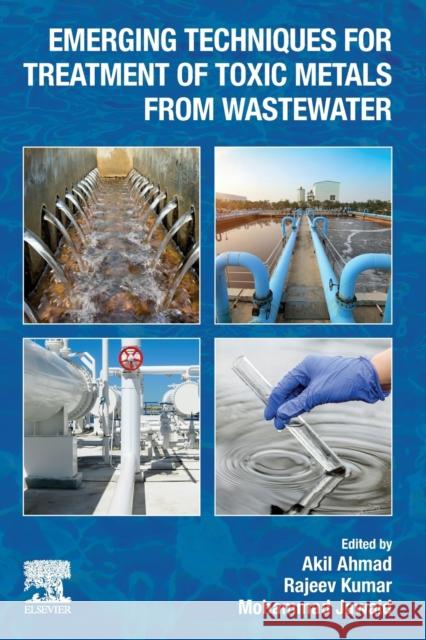


ISBN-13: 9780128228807 / Angielski / Miękka / 2022
ISBN-13: 9780128228807 / Angielski / Miękka / 2022
Part One: General Introduction on remediation techniques 1. Introduction of adsorption techniques for heavy metals remediation 2. Membrane technology for separation of heavy metals: Electronic and mechanical properties 3. Photocatalytic reduction of toxic metals from wastewater
Part Two: Adsorption/Sorption Process 4. Amberlite XAD resins for separation and preconcentration of metal ions 5. Plant leaves waste for removal of metal ions 6. Use of fruit seeds for toxic metal removal 7. Metal oxide-based nanocomposites for removal of metal ions from wastewater 8. Carbon based nanocomposites for metal remediation from wastewater 9. Metal removal through efficient nanofibers adsorbent 10. Wood based adsorbents for removal of metal ions 11. Activated carbon as potential material for metal removal 12. Clay based adsorbent for wastewater treatment 13. Fruit peel used as effective materials for metal remediation from environment
Part Three: Membrane Technology 14. Graphene oxide-based Nano filtration membrane for separation of heavy metals 15. Use of PVDF membrane for wastewater purification 16. Polyethersulfone (PES) Nano filtration membrane for treatment of toxic metal contaminated water 17. Reverse osmosis for separation of water pollutants 18. New generation polymeric membrane for removal of heavy metals 19. Hydrophilic nanoparticles incorporation on PES membrane for metal rejection 20. Removal of metal ions using coagulation-microfiltration membrane 21. Potential use of ultrafiltration membrane for remediation of metal contaminants 22. Application and fabrication of nanofiltration membrane for separation of metal ions from wastewater 23. Micellar enhanced ultrafiltration (MEUF) for treatment of wastewater
Part Four: Photocatalytic reduction 24. Use of mesoporous TiO2 for photocatalytic reduction of metal contaminants 25. Metal oxide doped nanocomposites for reduction of metal ions 26. Photocatalytic oxidation for wastewater treatment 27. Photocatalytic reduction of highly toxic Lead and Cadmium from aqueous solution 28. Divalent metals reduction using Graphene based nanocomposites under UV-Vis irradiation 29. Polymer based nanocoposites for metal reduction from aqueous solution 30. Metal-organic framework for reduction of heavy metals 31. Use of Carbon based photocatalyst for metal removal
Akil Ahmad is a Research Fellow at University of KwaZulu Natal, South Africa as Postdoctoral Fellow. He was previously Visiting Researcher of Chemical Engineering, Centre of Lipid Engineering and Applied Research, University Technology Malaysia (UTM), Malaysia. His research interest in the areas of environmental pollutants and their safe removal, synthesis of nanoparticles and Nano-sorbents (GO, CNT), photo-degradation and antimicrobial effects, preparation of various Chelating sorbents/adsorbent to prevent the environment, water and wastewater treatment, adsorption and ion-exchange, instrumental methods of analysis, thermodynamic and kinetic studies, and preconcentration and method validation with standard reference materials. Rajeev Kumar received a M.Sc. in Analytical Chemistry (2006), and M. Phil (2008) and Ph.D. degree in Applied Chemistry (2011) from Aligarh Muslim University, India. He is currently working as associate professor at the Environmental Science Department, King Abdulaziz University, Jeddah, Saudi Arabia. His research activities are in the areas of wastewater treatment and material science. Rajeev studies the adsorption and photocatalytic properties of the nanomaterials for the removal of contaminants from wastewater. He has published more than 50 research articles and chapters in the journals such as the Chemical Engineering Journal, Journal of Colloid and Interface Science, RSC Advances, Journal of Environmental Sciences, Journal of environmental management, Journal of Industrial and Engineering Chemistry, Desalination etc. Mohammad Jawaid is Fellow Researcher (Associate Professor) at the Biocomposite Technology Laboratory, Institute of Tropical Forestry and Forest Products (INTROP), Universiti Putra Malaysia, Serdang, Selangor, Malaysia and also Visiting Professor at the Department of Chemical Engineering, College of Engineering, King Saud University, Riyadh, Saudi Arabia since June 2013. He is also Visiting Scholar to TEMAG Labs, Department of Textile Engineering, Istanbul Technical University, Istanbul, Turkey. Previously he worked as Visiting Lecturer, Faculty of Chemical Engineering, Universiti Teknologi Malaysia (UTM) and also worked as Expatriate Lecturer under UNDP project with Ministry of Education of Ethiopia at Adama University, Ethiopia. He received his Ph.D. from Universiti Sains Malaysia, Malaysia. He has more than 10 years of experience in teaching, research, and industries. His area of research interests includes Hybrid Reinforced/Filled Polymer Composites, Advance Materials: Graphene/Nanoclay/Fire Retardant, Lignocellulosic Reinforced/Filled Polymer Composites, Modification and Treatment of Lignocellulosic Fibres and Solid Wood, Nano Composites and Nanocellulose fibres, Polymer blends. So far he has published 5 books, 12 book chapters and more than 130 International journal papers. He has had 4 review papers in the Science Direct Top 25 hot articles 2014-2015. He is also the Deputy Editor-in-Chief of Malaysian Polymer Journal and Guest Editor for Current Organic Synthesis and Current Analytical Chemistry. He is reviewer of several high impact ISI journals (44 Journals).
1997-2025 DolnySlask.com Agencja Internetowa







